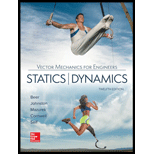
Concept explainers
(a)
Find the angular acceleration of the bar DE.
(a)
Answer to Problem 15.135P
The angular acceleration of bar DE is
Explanation of Solution
Given information:
The constant angular velocity of AB is
Calculation:
Consider the bar AB.
Show the position
Calculate the velocity at B using the relation:
Substitute
Consider the object BDF.
Consider the position of the point D with respect to B is denoted by
Consider the position of the point F with respect to B is denoted by
Consider the angular velocity of the bar BD is denoted by
Calculate the velocity at D using the relation:
Substitute
Consider the bar DE.
Consider the position of the point D with respect to E is denoted by
The velocity at E is
Calculate the velocity at D using the relation:
Substitute
Equate Equation (1) and (2).
Equate i component of Equation (3) as follows:
Equate j component of the Equation (3).
Substitute
The angular acceleration of AB is
Consider the bar AB.
Calculate the acceleration at B using the relation:
Substitute 0 for
Consider the object BDF.
Calculate the acceleration at D using the relation:
Substitute
Consider the bar DE.
Calculate the acceleration at D using the relation:
Substitute
Equate Equation (4) and (5).
Equate i component of Equation (6).
Thus, the angular acceleration of DE is
(b)
Find the acceleration of point F.
(b)
Answer to Problem 15.135P
The acceleration at F is
Explanation of Solution
Given information:
Calculation:
Refer Part (a).
Consider the position of the point F with respect to point B is denoted by
Calculate the velocity
Substitute
Calculate the magnitude of acceleration at F using the relation:
Find the direction of the acceleration at F as follows:
Thus, the acceleration at F is
Want to see more full solutions like this?
Chapter 15 Solutions
Loose Leaf for Vector Mechanics for Engineers: Statics and Dynamics
- 180- Dimensions in mm 100 100 D E Steel B Brass 60 kN 40 kN 40-mm diam. 30-mm diam. PROBLEM 2.40 Solve Prob. 2.39, assuming that rod AC is made of brass and rod CE is made of steel. PROBLEM 2.39 Two cylindrical rods, one of steel and the other of brass, are joined at C and restrained by rigid supports at A and E. For the loading shown and knowing that E = 200 GPa and E, 105 GPa, determine (a) the reactions at A and E, (b) the deflection of point C. = R = 45.5 kN ← Aarrow_forwardDimensions in mm 100 100 -180- -120-+- C D Steel B Brass 60 kN 40 kN 40-mm diam. 30-mm diam. E PROBLEM 2.39 Two cylindrical rods, one of steel and the other of brass, are joined at Cand restrained by rigid supports at A and E. For the loading shown and knowing that E = 200 GPa and E₁ = 105 GPa, determine (a) the reactions at A and E, (b) the deflection of point C.arrow_forward(read image) (Answer: vE = 0.514 m/s)arrow_forward
- 0.36 m Problem 2.27 P=5kN D Each of the links AB and CD is made of aluminum (E=75 GPa) and has a cross-sectional area of 125 mm². Knowing that they support the rigid member BC, determine the deflection of point E. B E 0.44 m 0.20 marrow_forward(read image) (Answer Given)arrow_forward(read image) Answer: A = 1192 Narrow_forward
- The correct answer is ~168 MPa, how was this found?arrow_forwardAir enters the compressor of a regenerative gas turbine engine at 310 K and 100 kPa, where it is compressed to 900 kPa and 650 K. The regenerator has an effectiveness of 75%, and the air enters the turbine at 1400 K. Assume variable specific heats for air. For a turbine efficiency of 90 percent, determine the amount of heat transfer in the regenerator. The amount of heat transfer in the regenerator is kJ/kg.arrow_forwardAir enters the compressor of a regenerative gas turbine engine at 310 K and 100 kPa, where it is compressed to 900 kPa and 650 K. The regenerator has an effectiveness of 79 percent, and the air enters the turbine at 1400 K. Assume constant specific heats for air at room temperature. The properties of air at room temperature are cp = 1.005 kJ/kg·K and k = 1.4. For a turbine efficiency of 90 percent, determine the amount of heat transfer in the regenerator. The amount of heat transfer in the regenerator is kJ/kg.arrow_forward
 Elements Of ElectromagneticsMechanical EngineeringISBN:9780190698614Author:Sadiku, Matthew N. O.Publisher:Oxford University Press
Elements Of ElectromagneticsMechanical EngineeringISBN:9780190698614Author:Sadiku, Matthew N. O.Publisher:Oxford University Press Mechanics of Materials (10th Edition)Mechanical EngineeringISBN:9780134319650Author:Russell C. HibbelerPublisher:PEARSON
Mechanics of Materials (10th Edition)Mechanical EngineeringISBN:9780134319650Author:Russell C. HibbelerPublisher:PEARSON Thermodynamics: An Engineering ApproachMechanical EngineeringISBN:9781259822674Author:Yunus A. Cengel Dr., Michael A. BolesPublisher:McGraw-Hill Education
Thermodynamics: An Engineering ApproachMechanical EngineeringISBN:9781259822674Author:Yunus A. Cengel Dr., Michael A. BolesPublisher:McGraw-Hill Education Control Systems EngineeringMechanical EngineeringISBN:9781118170519Author:Norman S. NisePublisher:WILEY
Control Systems EngineeringMechanical EngineeringISBN:9781118170519Author:Norman S. NisePublisher:WILEY Mechanics of Materials (MindTap Course List)Mechanical EngineeringISBN:9781337093347Author:Barry J. Goodno, James M. GerePublisher:Cengage Learning
Mechanics of Materials (MindTap Course List)Mechanical EngineeringISBN:9781337093347Author:Barry J. Goodno, James M. GerePublisher:Cengage Learning Engineering Mechanics: StaticsMechanical EngineeringISBN:9781118807330Author:James L. Meriam, L. G. Kraige, J. N. BoltonPublisher:WILEY
Engineering Mechanics: StaticsMechanical EngineeringISBN:9781118807330Author:James L. Meriam, L. G. Kraige, J. N. BoltonPublisher:WILEY





